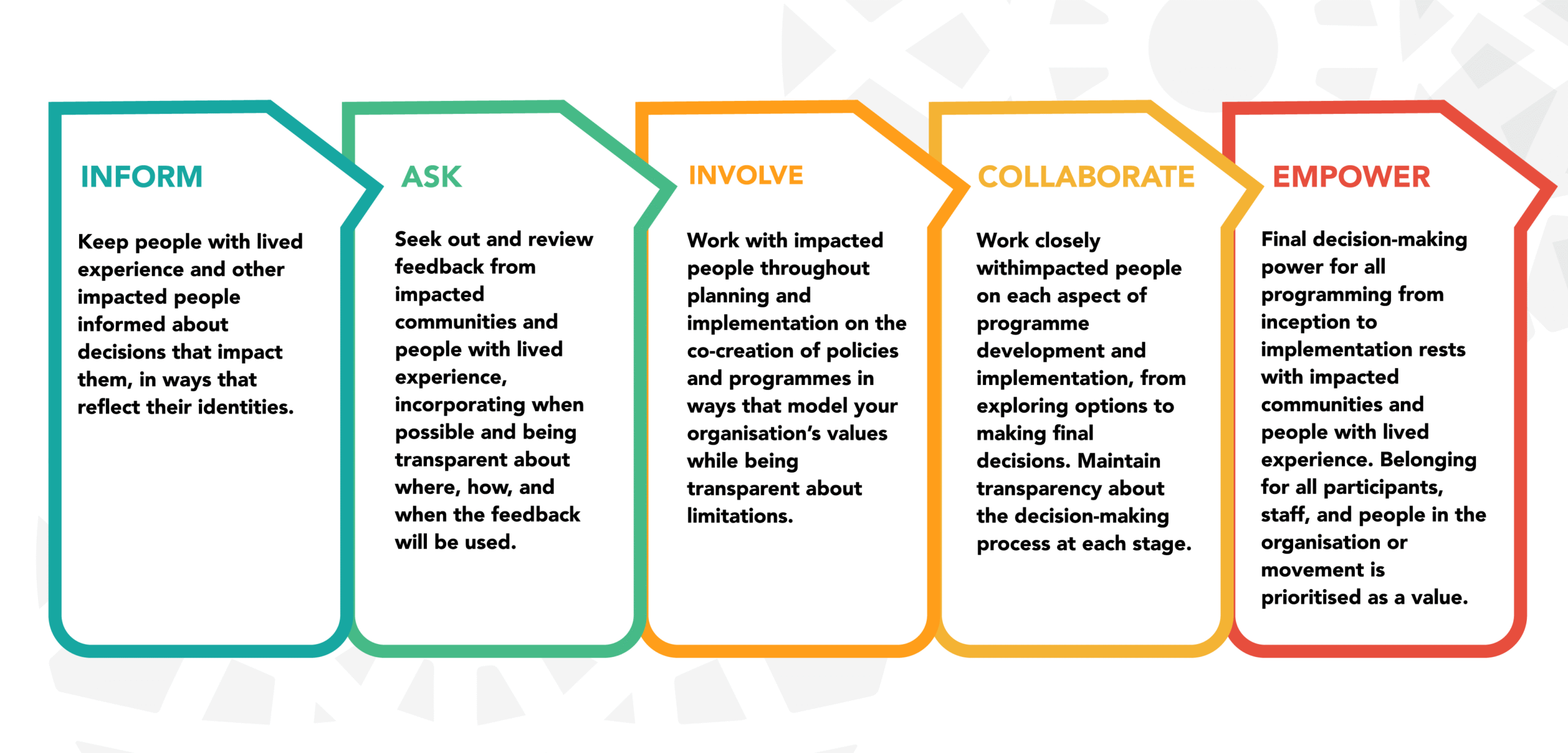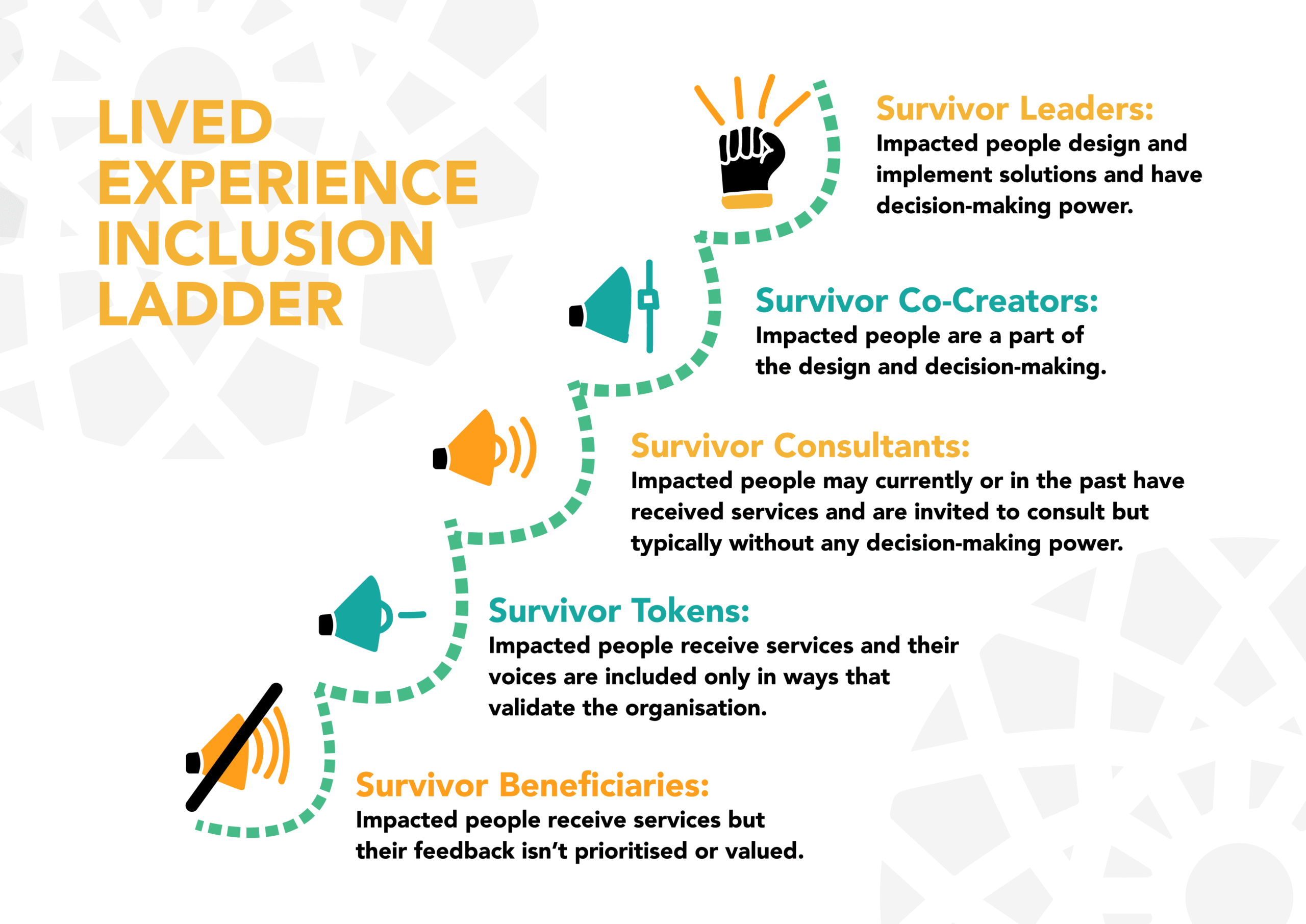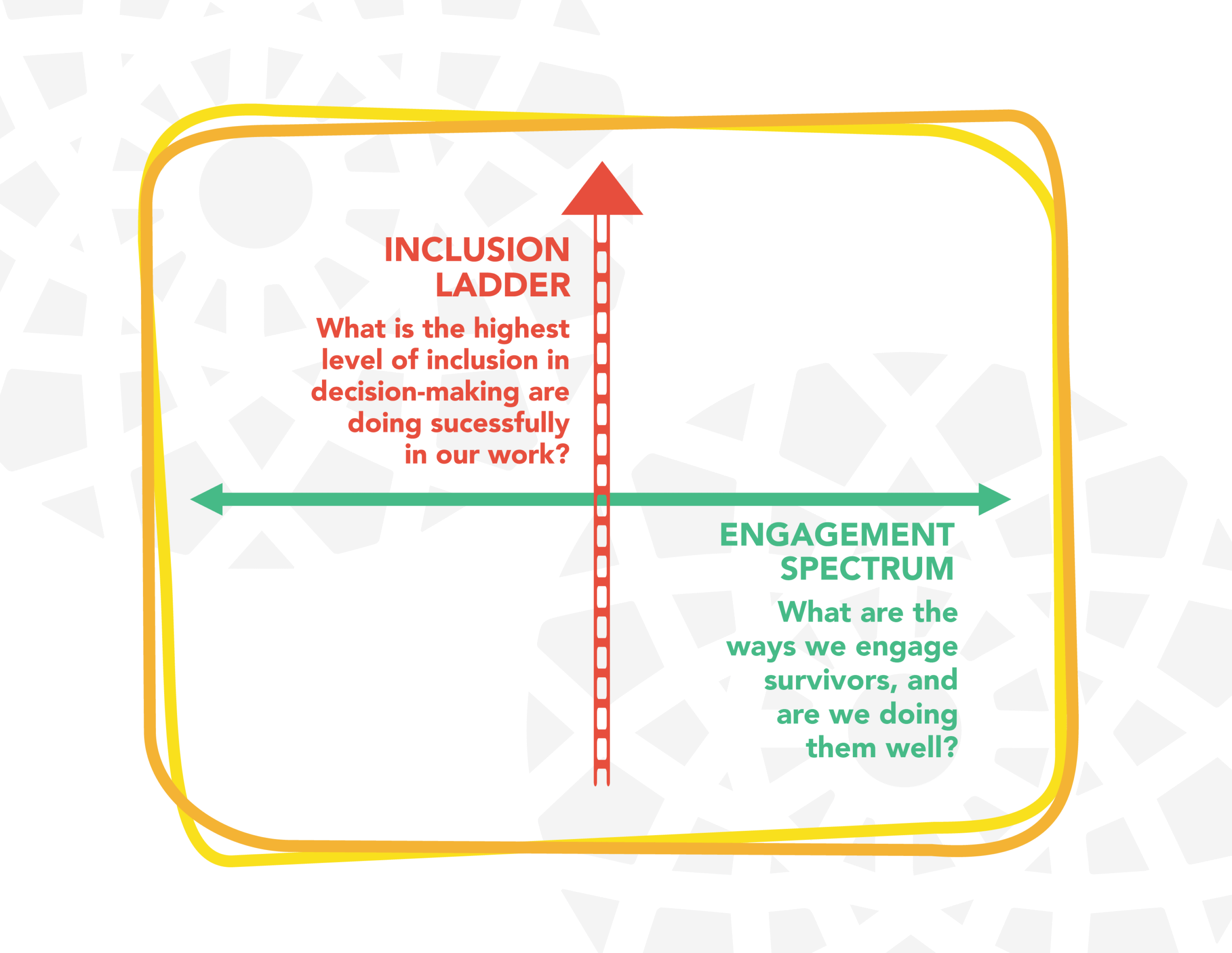
Any time the majority of people making decisions about or developing solutions to an issue are not from the communities most impacted by those issues, their solutions will fall short. When the people directly impacted by an issue are integrated throughout the systems that address their issues – in leadership, in planning, in implementing, and in learning and evaluation – our work will be more sustainable and our solutions more relevant. The services we provide will be more accessible and meaningful. The policies we create will be better able to address the issue while minimising harmful impacts.
Our framework, which is outlined in greater detail in The Meaningful Engagement Handbook, outlines six levels of engagement that people with lived experience may have with organisations. These levels are outlined in the first element of our framework: The Lived Experience Engagement Spectrum:

It is important that people with lived experience are engaged thoughtfully at each level of the spectrum. Even organisations led by people with lived experience at the Empower level should also consider how well they are doing on Inform and Ask.
Organisations that have not typically had lived experience leadership may do well at the Inform or Ask level but should maintain a commitment to intentional improvement on other levels. This is reflected in the second element of our framework: The Lived Experience Inclusion Ladder.

Organisations can focus on strengthening their meaningful engagement practices at every level of the spectrum while intentionally striving to use the highest possible levels of engagement on any programme, project, or organisation.
This requires intentional reflection on belonging, meaningful engagement, and inclusion. The Meaningful Engagement Handbook provides concepts and strategies to inform and improve meaningful engagement within organisations.
Put together, the Lived Experience Engagement Spectrum and the Lived Experience Inclusion Ladder create a robust framework that expands the circle of belonging to everyone, fostering healthy movements and strong, community-centred organisations.

Absolutely! People with lived experience have often been marginalised from access to safety, support, and resources. This means that they may have had less access to formal education, professional development, or work experience in similar fields. Professional development and work opportunities for impacted people is an essential part of meaningful engagement.
In our experience (and the experience of the numerous people whose feedback has guided this work), even when impacted people have similar (or better) qualifications to their non-impacted colleagues, they are often still excluded from leadership, considered less qualified, or perceived as less competent or capable. These impacts of bias cannot be removed by providing additional training or opportunities for people with lived experience. They require ongoing commitment to learning about, reflecting on, and transforming the systemic, cultural, and organisational dynamics that perpetuate cycles of exclusion, prejudice, and invalidation. The Meaningful Engagement Toolbox includes numerous tools to support organisations in that process.
Belonging is a deep knowing and experience of being at home – in your body and in your social and physical environment. Belonging gives you the foundation to be able to thrive. Belonging happens only when there is co-creation and co-ownership. It is both a practice and a feeling: an ongoing practice of collaborative creation that results in a feeling of being seen, welcomed, and at ease. In a healthy movement, everyone feels belonging. The movement centres people with lived experience while building collective power, and that means that everyone should belong. While the movement is “people with a shared experience of injustice” who organise for their collective power, our understanding of belonging without othering frames that power as “power with” rather than “power over.” This means that belonging is for everyone, centring impacted people but with belonging also accessible for those without lived experience.
The Meaningful Engagement Toolbox consists of two main parts: The Meaningful Engagement Handbook and the accompanying tools.
You may view all the available tools here: Tools Library. Development of new tools is an ongoing process and we are continually developing new tools with our partners in response to their needs.
No. Many of the tools can be used by any organisation at any time. However, the framework explains the “why” for the tools, so we recommend that organizations have basic familiarity with the framework before editing or adapting the tools.
Contact CTI to learn more about available support options. CTI has some resources directly available and may know of trained technical assistance providers in your region.
We measure what we value. Organisations may be expected to also measure things based on funder requirements, but beyond that evaluation can provide a systematic process for measuring meaningful engagement with people with lived experience over time. Evaluating your organisation’s lived experience engagement strengths and areas for growth will help you assess how you are doing, determine a plan for continuous quality improvement, and track your progress over time.
Evaluation is often viewed by organisations as either a funder chore (“We do this to keep getting funded so we must look good to our funders”) or a scary task (“What if we don’t score well? Does that mean we’re bad at our work?”). In reality, your “score” is less important than what you do with the results of the assessment. The scores on the assessments and averages in your analysis do not tell you whether or not you are succeeding or failing, or whether or not you should be proud or ashamed. Rather, they give you information that you can use to have a more impactful strategy. The goal is not to compare yourself with other organisations – “Who scored higher? Does that mean they’re better than us?” The goal is to evaluate your own organisation, identify and prioritise follow-up actions, and develop a strategy for implementing changes. This is continual quality improvement, and demonstrating a commitment to CQI speaks volumes about the intentions of your work!
Yes! CTI regularly offers a Meaningful Engagement Organisational Coach Training to prepare individuals from impacted communities to provide technical assistance to organisations working with this framework and these tools. Follow CTI for announcements on when updated trainings will roll out.